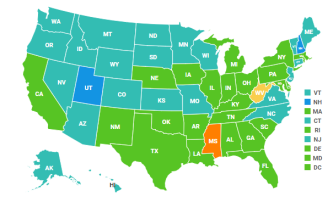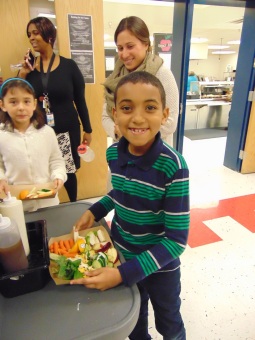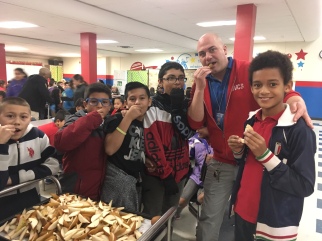A new report from the Campaign to End Obesity examining the economic impact of healthier school lunches serves as a long-awaited validation of Real Food for Kids’ advocacy work with our school systems.
As implemented in many school districts across the country, The National School Lunch Program is an under-leveraged resource in lowering childhood obesity, increasing academic performance and elevating economic opportunity.
The report illustrates how healthier school meals may contribute to lower childhood obesity rates and improve outcomes for children, both during their school years and into adulthood.
Last year, Real Food for Kids launched The Lunch Room Collective, a collaborative of public and private partners. dedicated to raising the profile of and conversation around school meals as a catalyst for change in public health and advance programs and policies leading to a systematic change in the way we feed students.
Lower childhood obesity rates have the potential to increase academic performance and boost educational attainment, such as high school graduation and higher education. Researchers have already drawn the link between healthier foods consumed at schools and increased test scores, citing students’ ability to pay attention in class, have fewer absences and fewer behavioral issues as the benefits.
Obesity-related illnesses can interfere with a student’s ability to do well in the classroom, both academically and physically. Obesity in children has been connected with lower high school graduation rates and lower college attendance, impacting job opportunities and wage growth.
Adults with higher levels of educational attainment tend to have better job opportunities and earnings potential. Healthy-weight adults are, on average, more productive at work and miss fewer work days. As a result, research finds that they often earn higher wages than adults with obesity.
Because childhood obesity is a strong predictor of adult obesity – up to 95% – lowering childhood obesity should lead to lower rates of adult obesity. Today, the rate of obesity among U.S. adults exceeds 35% in seven states, 30% in 22 states and 25% in 19 states. Obese adults are those with a Body Mass Index, or BMI, over 30. Adults with obesity and related diseases face medical expenses up to 100% greater than healthy-weight adults.
The Campaign report uses findings from numerous academic studies in economics, public policy, and public health to illustrate the connections between healthier school meals and childhood obesity, academic, and economic outcomes.
Among the findings, if healthier school meals were implemented in all public elementary schools, are:
- 200,000 fewer children with obesity in each annual class
- Higher academic attainment: 40,000 additional high school graduates, 9,000 additional college graduates – per year
- Increased yearly income of $1.1 billion – for each annual class – a lifetime increase of $44 billion
- $3.8 billion lifetime savings in obesity-related healthcare costs
“Taken together, each annual class of students receiving healthier school lunches throughout their elementary school career would generate $47.8 billion of lifetime benefits for themselves and the US economy.”
The number of obese children in the United States has tripled in the last three decades. During the same period, the adult obesity rate has also increased significantly, in part due to children with obesity becoming adults with obesity.
For many students, food sold and served at school, through breakfast and lunch programs as well as vended snacks and bottled drinks, makes up a substantial part of their diet. More than 30 million students nationwide participate in the National School Meals Program; 51% qualify for free or reduced-price meals. For children from low-income families especially, school meals are a critical source of affordable, healthy foods.
If healthier school meals can improve health outcomes, lead to better academic performance, higher educational attainment, increased opportunities in the workforce and economic growth, as well as significantly reduce spiraling healthcare costs, it is critical to support policies that meet or exceed nutrition standards for school meals and snacks, but also examine environmental factors in our school cafeterias that impact students’ eating behaviors, work now underway through The Lunch Room Collective.
It is also essential to support local school nutrition professionals in advancing culinary initiatives that can lead to these improved outcomes for our students. In many cases, this involves shifting the mindset of our school district leaders toward a more whole-child focus, embracing school meals as an integral piece of the academic experience.
Sign up for more from Real Food for Kids
Follow us on Facebook and Twitter


 For more than a decade, the annual The
For more than a decade, the annual The  For school-aged children, ages 5-18, the focus of
For school-aged children, ages 5-18, the focus of 





 Last month, Real Food for Kids Alexandria hosted a food tasting at
Last month, Real Food for Kids Alexandria hosted a food tasting at 
 Real Food for Kids Alexandria assisted ACPS with the rollout of Greens & More by building excitement for the launch. Students decorated empty walls outside the cafeteria with vegetable-themed drawings and during the first week the bar was open, parents helped students acclimate to the new process, such as reminding them to sanitize their hands and how to use utensils correctly and hygienically. But most fun was the student incentive – RFFK Alexandria promised that if all students tried the salad bar, their principals would dress up as vegetables!
Real Food for Kids Alexandria assisted ACPS with the rollout of Greens & More by building excitement for the launch. Students decorated empty walls outside the cafeteria with vegetable-themed drawings and during the first week the bar was open, parents helped students acclimate to the new process, such as reminding them to sanitize their hands and how to use utensils correctly and hygienically. But most fun was the student incentive – RFFK Alexandria promised that if all students tried the salad bar, their principals would dress up as vegetables!